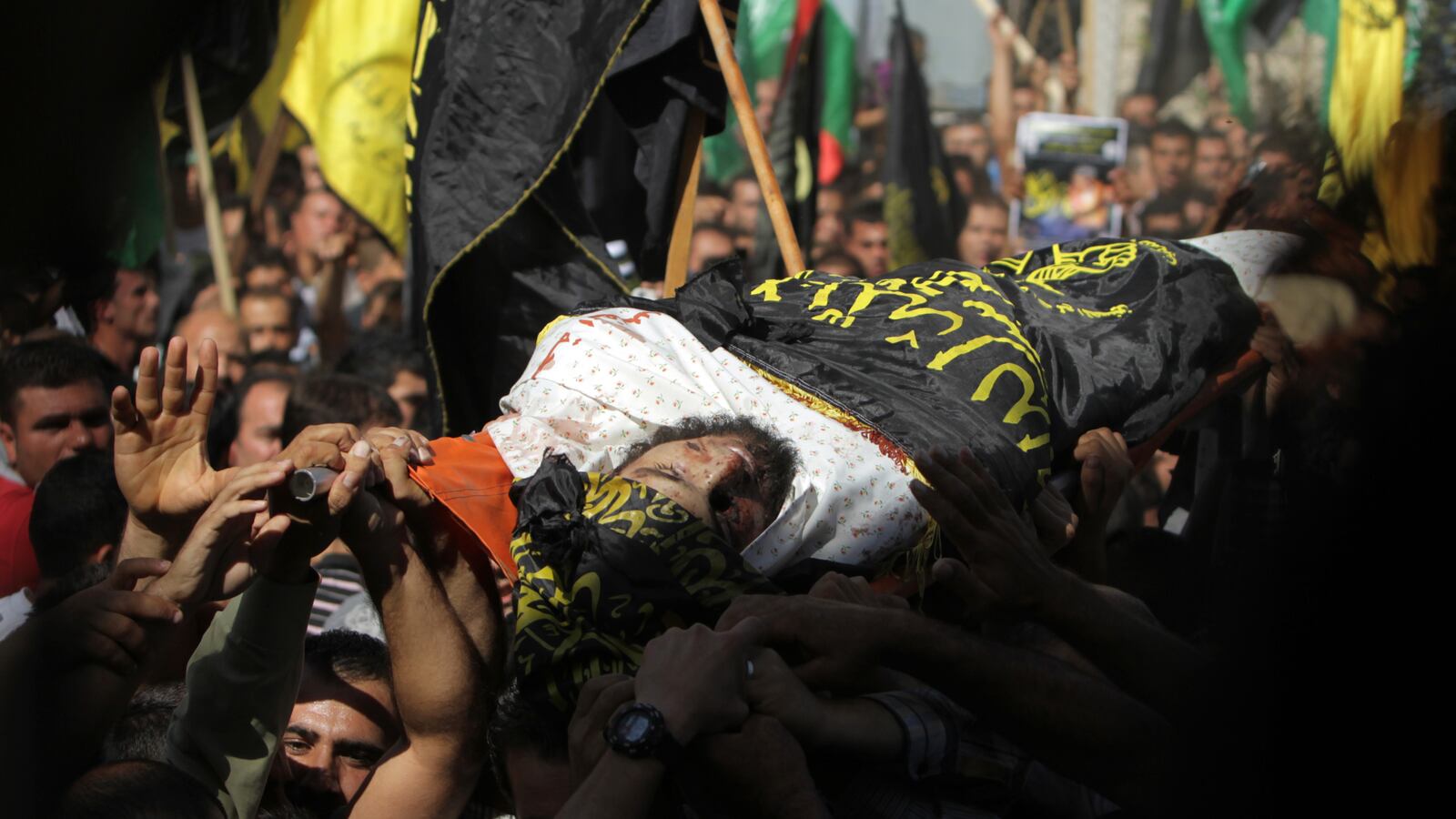RAMALLAH—As frustration at Israeli military violence and the lack of progress in unarmed protests builds in the occupied West Bank villages bordering Israel, Palestinian residents feel they are being pushed towards armed struggle.
Killed by the Israeli army in a cave last Tuesday following a shoot-out on the edge of the village of Bi’lin—where weekly unarmed protests against Israel’s separation wall have raged for 9 years—Islamic Jihad fighter Mohammed Assi, 28, has become an instantly admired symbol of resistance.

Thousands of people from the surrounding villages gathered on October 23 in Assi’s small hometown of Beit Liqya, about ten kilometers from Bi’lin, to remember the fallen fighter accused of involvement in the Tel Aviv bus bombing in front of Israel’s Ministry of Defense at the end of the last Gaza war.In a rare display for the Fatah-controlled West Bank these days, mourners carrying Assi’s body from the morgue in Ramallah to Beit Liqya fronted their procession with Islamic Jihad and Hamas flags.
It was a harkening back to the image of the second Intifada, and leading Islamic Jihad figure and former Palestinian prisoner released by Israel after more than two months on hunger strike, Khader Adnan, promised the fight would continue. Simultaneously denying that Islamic Jihad ordered the Tel Aviv bombing that injured 29 people and pledging revenge, he indicated that a campaign of armed struggle looms.
“The Palestinian fighters are waking up after sleeping for a long time,” he said. However, unlike at the Hebron-area funerals this past year, where masked fighters aligned with Fatah made their presence known, no fighters appeared to display their weapons or fire into the air in tribute.
For many in the crowds at the funeral, Assi’s life and death were seen as the symbol of an uncompromising fight against decades of military rule. The story of this young man—attacking Tel Aviv in response to the 2012 Israeli assault on Gaza, hiding in caves to evade Israeli capture for almost a year, and then being killed by overwhelming force in a three-hour-long fire fight—became instant folklore.
It was a marked change from the despair and anguish that cloaks most West Bank funerals for those who have fallen as a result of the occupation. Instead of being overpowered by the hopelessness that so often accompanies the death of an unnamed Palestinian civilian, Assi’s funeral was marked by admiration for a young man who fought back.
“This man was a martyr and a resistance fighter and I have all the respect for people like that,” said Ali Jawar, a middle-aged man in the funeral march. “The settlers are committing crimes every day and the army provides them cover while the Palestinian Authority stays away,” added the man from the West Bank town of Bir Nabala. He noted that both unarmed protest and armed resistance are necessary to make Israel understand the cost of its occupation.
Still, behind the mythology surrounding Assi, the account of his life and death by family members depicts a more complex reality of what drove him to arms. According to Assi’s father Raba, his son was driven to clandestine action as the result of constant abuse he faced in Israeli prison. Assi’s twin brother is currently in Israeli detention.

“He spent a lot of time being tortured and beaten while arrested. So what do they expect a person’s reaction to be,” said Raba Assi of his son while sitting with family members outside his home. He described how even after his son tried to avoid political activity or involvement in Islamic Jihad after one of his prison releases, he was still targeted by Israel and rearrested. As a result, his family said that after his last release from prison in September 2012, Assi swore never to return to jail.
“As you can see, he didn’t go and became a martyr,” said his father, who denies his son was involved in the Tel Aviv bombing. He believes the fruitlessness of 20 years of negotiations, combined with continuing expansion of Israeli settlements and the separation wall, pushed his son to embrace armed struggle.
“We have been in negotiations for decades and nothing has come of it. They built the wall and now the wall has become a reality,” said Raba Assi. “What is left? [Israel is] asking for people to come and resist them.”
Assi’s older brother Jihad chimed in to argue that unarmed protest is futile under these conditions. “We have tried the peaceful resistance,” he said. “Peaceful resistance goes hand in hand with negotiations,” he added, describing the lack of Israeli concession to basic Palestinian rights as proof of its unwillingness to negotiate a just solution.
It’s a perspective that Bi’lin popular struggle leader Abdullah Abu Rahmeh concedes is gaining strength in surrounding villages after nine years of local protests have yielded few results.
“It is getting harder and harder to convince other villages to take up popular struggle,” he said after last Friday’s demonstration, dedicated to remembering Assi’s death. He contended that while he and Bi’lin are steadfastly committed to unarmed protest, if people don’t see any real Israeli concessions, many will be driven to arms.
Many Bi’lin residents attended Assi’s funeral, which, according to Abu Rahmeh, is the result of the shock at the scale of violence used on the edge of their town. He described waking up in the early hours of October 22 to the sounds of sporadic gunfire followed by a loud explosion. When he left the house he was met with a scene of the village under army control, while local residents massed unsuccessfully to try and retrieve the body.
Abu Rahmeh said that by the time the residents were finally able to reach the cave, the army had cleared up most signs of the clash with a bulldozer.

The signs of an Israeli attempt to mask the events surrounding the fire fight around the cave were clear two days after the clash. While blood splatters were found above the cave and mixed into the cave’s rubble, a path of dead olive trees and crushed vegetation marked the path of a bulldozer. Yet there were no bullet casings lying around. Nor were there any real signs of the use of a rocket, which the Israeli army claimed to have used to kill Assi. Only a grenade pin and a few pieces of shrapnel could be found in the vicinity of the cave.
It was overwhelming Israeli military superiority, demonstrated over and over in cases like Assi’s, that provoked villages like Bi’lin to take up unarmed protest. As last Friday’s small demonstration in the town ended in the usual charge of Israeli soldiers and a blanket of teargas, the act seemed more like a ritual held in the absence of any alternative. With the West Bank relatively quiet and the potential for a popular uprising seeming ever more distant, people in the birthplace of post-Intifada protest are increasingly looking to the past and hoping for a different outcome.





